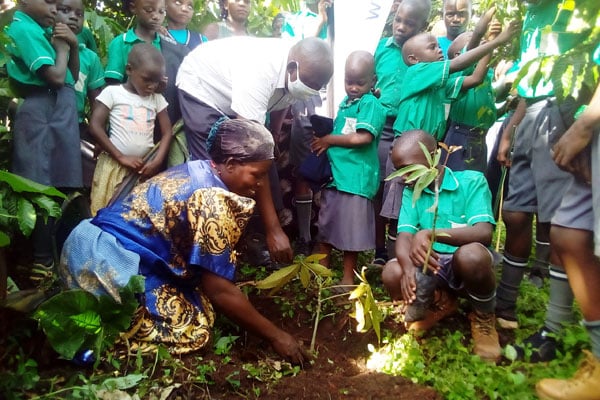How sugarcane, pineapple growing has inspired drive to plant more trees in Kayunga

Mr Stephen Ssemutumba (centre), the Buvad executive director with pupils launch the tree planting campaign in Kisoga village, Nazigo sub-county on May 13, 2022. PHOTO/FRED MUZAALE
What you need to know:
Kayunga District, particularly in Bbaale County has of recent become a sugarcane growing area by big sugar companies such as Scoul, Madhivani and GM sugar plus a number of out growers who have cleared big chunks of forests to paver way for cane growing
The booming sugarcane and pineapple growing, which has led to massive destruction of forests in Kayunga District has prompted institutions and authorities in the area to team up to restore depleted forest cover.
Statistics show that a total of 15,968 (14.7 percent) hectares of tree cover has been lost in Kayunga District between 2001 and 2020.
The problem, authorities in the District led by the senior district environment officer, Mr Patrick Musaazi say, has been further exacerbated by a plan by area members of parliament to move a motion before the House, asking for the degazettement of the already depleted forest reserves in some areas such as Bajjo forest reserve for establishment of an industrial park.
READ: He has made a fortune by adding value to sugarcane
Kayunga District, particularly in Bbaale County has of recent become a sugarcane growing area by big sugar companies such as Scoul, Madhivani and GM sugar plus a number of out growers who have cleared big chunks of forests to paver way for cane growing.
On the other hand, pineapple farmers in the sub-counties of Kangulumira, Nazigo and Kayunga have also cut down trees to grow pineapples.
The farmers say sugarcane and pineapple don’t do well when grown within or under trees.
To restore the depleted forest cover, Butakoola village association for development (Buvad) a local non- government organization, has teamed up with institutions which include schools, health units, religious bodies, Bunyala cultural institution, Buganda kingdom and the district leadership to plant a total of 25,000 fruit trees in the district.
The tree-planting campaign was launched on Friday by Mr Stephen Ssemutumba, the Buvad executive director at Gramos primary school in Kisoga village, Nazigo sub-county.
During the launch, pupils and a number of residents planted cashew nut trees, mangoes, jack fruit and other fruit trees.
He said since children are change agents in the communities they live, they would be involved in the tree planting campaign so that they also teach and interest their parents to plant trees.
“90 percent of the locals in this district rely on agriculture for their livelihood; however, all native vegetation has been destroyed to pave way for sugarcane and pineapple growing plus other human activities like construction,” Mr Ssemutumba said.
“The current floods that have displaced a number people in Bbaale County have occurred because people have cut down all the trees and vegetation cover that were acting as buffer zones for the water bodies. We need to come out strongly to protect the environment.”
A number of families, schools, gardens in Galilaaya sub-county have been displaced by floods and plans by the government to resettle them are yet to be carried out.
According to Mr Ssemutumba, they would plant fruit trees which he said have a number of benefits like providing fruits, sheds, being wind breakers plus emitting oxygen to the environment.
Mr Patrick Musaazi, the district senior environment officer said the most affected areas with forest destruction include the cattle corridor area of Bbaale County, where he said almost half of the tree cover in the area has been cut down by forest encroachers.
“We are going to join hands to replant the lost tree cover and we hope by December this year we would have replanted about 25,000 trees,” Mr Musaazi said.
He said they also plans to evict wetland encroachers, some of whom have already been arrested in Ssezibwa wetland and are on remand awaiting prosecution in courts of law.




